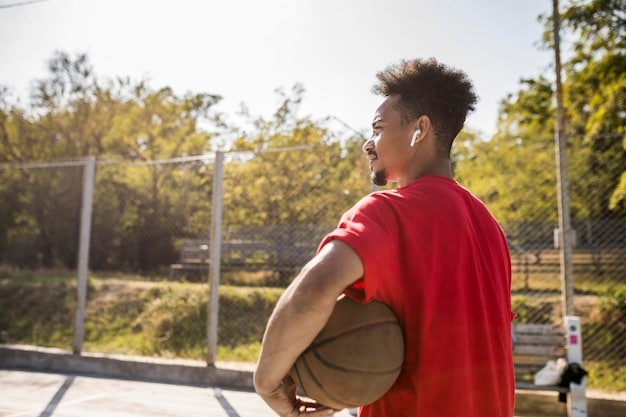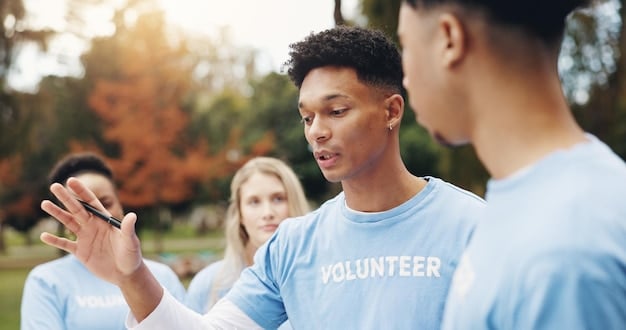Maximize College Scholarship Chances: Strategic Skill Development for High School Athletes

High school athletes can significantly increase their chances of earning a college scholarship by strategically developing their skills, focusing on both athletic prowess and academic excellence, while actively engaging with college recruiters and maintaining a strong online presence.
For many aspiring athletes, the dream of playing at the collegiate level is intertwined with the opportunity of earning a college scholarship. This isn’t merely about raw talent; it’s a multifaceted journey that demands dedication, strategic planning, and an understanding of what college programs truly seek. To answer the pressing question of How Can High School Athletes Maximize Their Chances of Earning a College Scholarship Through Strategic Skill Development?, we delve into a comprehensive approach that transcends the playing field, embracing academic rigor, personal character, and effective self-promotion. By integrating these elements, athletes can significantly enhance their prospects, turning ambition into achievement.
Laying the Foundation: Skill Development Beyond the Basics
Achieving a college scholarship in athletics requires more than just being good at your sport. It demands a holistic approach to skill development that encompasses technical proficiency, tactical understanding, and physical conditioning. College coaches are looking for athletes who not only excel in their specific roles but also demonstrate versatility and a deep commitment to continuous improvement.
Beyond individual drills, understanding the nuances of team play is paramount. While individual skills are important, a player’s ability to fit into a team system, make smart decisions under pressure, and contribute to overall team success is often what sets them apart. This suggests a focus on developing game intelligence alongside physical attributes.
Mastering Fundamental Techniques
Every sport, regardless of its complexity, is built upon a foundation of fundamental techniques. For a basketball player, this might mean perfect shooting form or crisp passing. For a soccer player, it’s ball control, accurate passing, and precise shooting. Coaches value consistency and flawless execution of these basics.
- Consistent daily practice of core skills.
- Seeking expert coaching for technique refinement.
- Using video analysis to identify areas for improvement.
- Drilling under pressure to simulate game conditions.
Advanced Tactical Understanding
Once fundamentals are mastered, the next step is to develop a sophisticated understanding of game tactics. This involves understanding offensive and defensive schemes, situational awareness, and the ability to adapt to different game scenarios. Athletes who can think critically on the field or court are invaluable.
This tactical depth extends to understanding one’s role within the team. A scholarship athlete isn’t just a star player; they are a strategic asset who understands how their individual performance contributes to the team’s collective goals. They lead by example, making intelligent plays that elevate the entire team.
Ultimately, skill development is a never-ending process. The best athletes are those who are constantly seeking to learn, adapt, and refine their abilities, both individually and within the team context. This relentless pursuit of excellence is a key indicator for college recruiters.
Academic Excellence: The Unsung Hero of Scholarship Opportunities
While athletic prowess is undoubtedly a primary determinant for sports scholarships, academic achievement plays an equally critical, though often underestimated, role. College coaches and admissions committees stress the importance of a strong academic record, not just for eligibility purposes but also as an indicator of an athlete’s discipline, responsibility, and ability to handle the rigors of collegiate life.
It’s a common misconception that athletic talent alone can secure a scholarship. In reality, academic performance can open doors to a wider range of opportunities, including academic scholarships that can be combined with athletic aid, or even make an athlete a more attractive recruit for schools with high academic standards. Demonstrating a commitment to learning suggests resilience and intellectual curiosity.
Maintaining a High GPA
A high Grade Point Average (GPA) is the most straightforward demonstration of academic commitment. While minimum GPAs vary by division and institution, aiming for the highest possible GPA across core subjects is always advisable. This showcases dedication and capability.
- Prioritize core academic subjects (English, Math, Science, Social Studies).
- Seek tutoring or extra help when struggling with coursework.
- Communicate proactively with teachers and academic advisors.
- Balance study time effectively with athletic commitments.
Standardized Test Scores (SAT/ACT)
Standardized tests such as the SAT and ACT remain crucial components of college applications. Strong scores can significantly enhance an athlete’s profile, making them more appealing to a broader range of colleges, including those with competitive academic programs.
Many college athletic programs have internal academic standards that are higher than the NCAA minimums. Meeting or exceeding these standards can give an athlete a significant edge, especially in a competitive recruiting landscape. This preparation should ideally begin early in high school, allowing for multiple attempts to improve scores.
In essence, academic excellence is a non-negotiable aspect of the scholarship pursuit. It not only fulfills eligibility requirements but also signals to recruiters that an athlete is a well-rounded and responsible individual capable of thriving in a demanding collegiate environment, both academically and athletically.
Physical Conditioning and Injury Prevention: Building a Robust Athlete
The intensity of collegiate sports demands a high level of physical readiness. College coaches seek athletes who are not only skilled but also durable and capable of withstanding the rigorous training schedules and competitive environments. Strategic physical conditioning and an unwavering focus on injury prevention are fundamental pillars of scholarship readiness.
A well-structured strength and conditioning program is vital for enhancing athletic performance and reducing the risk of injury. This goes beyond simple workouts; it involves periodized training, targeting specific muscle groups, improving cardiovascular endurance, and developing agility and explosiveness relevant to the athlete’s sport. Recruits who exhibit peak physical condition demonstrate their readiness for the next level.
Sport-Specific Training Regimens
General fitness is a good starting point, but athletes must engage in sport-specific training that mimics the movements and demands of their respective disciplines. This includes power training for jumpers, endurance training for long-distance runners, or agility drills for team sport players.
- Work with certified strength and conditioning coaches.
- Incorporate plyometrics and speed training.
- Focus on core strength for overall stability.
- Monitor training load to prevent overtraining.
Prioritizing Rest, Recovery, and Nutrition
Often overlooked, adequate rest, recovery, and proper nutrition are as critical as training itself. These elements contribute significantly to an athlete’s ability to perform consistently, adapt to training loads, and prevent injuries. College coaches recognize athletes who demonstrate self-care and professional habits.

Effective injury prevention strategies should be integrated into every athlete’s routine. This includes proper warm-ups, cool-downs, flexibility training, and addressing muscular imbalances. Athletes who have a history of minimal injuries or demonstrate proactive measures for their physical health are often viewed favorably by recruiters.
Ultimately, being a physically robust and injury-resilient athlete is a key expectation for college programs. It signals reliability and underscores an athlete’s commitment to long-term performance, making them a valuable investment for any collegiate team seeking to build a strong and healthy roster.
The Recruiting Process: Navigating the Path to a Scholarship
Understanding and actively engaging with the college recruiting process is arguably as important as athletic and academic excellence. It’s a proactive journey where athletes must present themselves effectively to potential coaches and institutions. The recruiting landscape can be complex, but with strategic planning and consistent effort, athletes can significantly improve their visibility and opportunities.
The initial steps often involve creating a comprehensive athletic resume and highlight reel. These materials serve as an athlete’s first impression to coaches, showcasing their skills, dedication, and potential impact on a collegiate team. A well-produced highlight reel can capture attention, while a detailed resume provides essential context regarding athletic achievements, academic standing, and contact information.
Creating a Powerful Recruitment Profile
A compelling recruitment profile or package is essential. This includes a detailed athletic resume, an impressive highlight video, and academic transcripts. These materials should be professional, concise, and effectively highlight an athlete’s strengths.
- Include key stats, awards, and team achievements.
- Tailor highlight videos to showcase diverse skills and game situations.
- Ensure academic transcripts are up-to-date and accurate.
- Obtain strong letters of recommendation from coaches and teachers.
Proactive Communication with Coaches
Initiating communication with college coaches is crucial. This demonstrates genuine interest and proactiveness. Email, phone calls, and attending specific camps or showcases are all avenues for building relationships.
Personalized emails, rather than generic templates, can make a significant difference. Athletes should research the schools and programs they are contacting, mentioning specific reasons why they are a good fit. Following up consistently, without being overly persistent, shows professional courtesy and sustained interest. Attending unofficial visits or camps can also provide invaluable face-to-face interaction and allow coaches to assess an athlete’s personality and work ethic.
Navigating the recruiting landscape requires patience, persistence, and strategic self-promotion. By taking an active and informed approach, athletes can effectively market themselves, build meaningful connections with college coaches, and ultimately uncover the scholarship opportunities that align with their athletic and academic aspirations.
Character and Leadership: Beyond the Stat Sheet
While skills, academics, and physical prowess are quantifiable metrics, college coaches also place significant emphasis on an athlete’s character, leadership qualities, and overall demeanor. These intangible attributes speak volumes about an individual’s potential impact on a team’s culture, locker room environment, and ability to adapt to new challenges both on and off the field.
A strong character implies attributes like resilience, humility, teachability, and a positive attitude. Coaches are looking for athletes who can handle adversity, contribute positively to team dynamics, and act as role models. These qualities often outweigh raw talent in the long run, as they contribute to a cohesive and successful team environment.
Demonstrating Leadership On and Off the Field
Leadership isn’t always about being the team captain; it’s about influencing others positively through actions and attitude. This can involve setting a good example in practice, motivating teammates, or taking initiative in difficult situations.
- Be a positive example through work ethic and attitude.
- Hold yourself and teammates accountable.
- Communicate effectively and constructively.
- Embrace challenges and learn from mistakes.
Community Involvement and Sportsmanship
Participation in community service or demonstrating strong sportsmanship reflects a well-rounded individual who understands their role beyond just the sport. These activities showcase empathy, civic responsibility, and a commitment to personal growth.

Coaches often look for individuals who are not just skilled athletes, but good people. Sportsmanship, respect for officials, opponents, and teammates, and a willingness to help others underscore maturity and a team-first mentality. These actions outside competitive play can reinforce a positive image to recruiters.
Ultimately, an athlete’s character is a powerful differentiator. It indicates their coachability, their ability to be a positive influence, and their overall maturity. Investing in these soft skills can significantly enhance a scholarship candidate’s appeal, proving they are not just an athlete, but a valuable individual asset to any collegiate program.
Leveraging Technology and Professional Guidance
In the evolving landscape of sports recruiting, technology has become an indispensable tool for high school athletes seeking college scholarships. From creating compelling highlight reels to connecting with coaches across the nation, digital platforms offer avenues for increased visibility and streamlined communication. Similarly, professional guidance can provide invaluable insights and strategic support throughout the complex recruiting process.
Online athlete profiles and recruiting websites have become central hubs where prospects can upload videos, statistics, and academic information for coaches to access. These platforms allow athletes to proactively manage their presence and control the narrative of their athletic journey. Optimizing these profiles with detailed, up-to-date information is crucial for attracting attention.
Utilizing Online Recruiting Platforms
Platforms like NCSA, RecruitMe, and other sport-specific databases allow athletes to create profiles, upload videos, and connect directly with college coaches. These tools streamline the initial outreach process.
- Maintain a professional and updated online profile.
- Carefully select and edit highlight reels to showcase best plays.
- Use platform features to search for compatible programs and coaches.
- Track interactions and follow up with interested parties.
Seeking Professional Advice and Mentorship
Engaging with experienced recruiting advisors, former college athletes, or even current high school counselors specializing in sports can offer significant advantages. Their expertise can help navigate the complexities of NCAA rules, contact timelines, and scholarship negotiations.
Mentors can provide guidance on everything from crafting the perfect email to preparing for official visits. They can also offer an objective perspective on an athlete’s potential, helping them identify realistic targets and avoid common pitfalls. This professional insight can be the difference between merely being seen and truly being recruited.
By effectively leveraging technology and seeking out knowledgeable guidance, high school athletes can demystify the recruiting process, present themselves in the most favorable light, and significantly increase their opportunities to earn a college scholarship, ensuring their hard work pays off both on and off the field.
| Key Aspect | Brief Description |
|---|---|
| 💪 Skill Development | Go beyond basics to master advanced techniques and game intelligence. |
| 📚 Academic Excellence | Maintain high GPA and strong test scores; vital for eligibility and appeal. |
| 🩹 Injury Prevention | Prioritize physical conditioning, rest, and nutrition for durability. |
| 🗣️ Proactive Recruiting | Create strong profiles and communicate early with coaches. |
Frequently Asked Questions About Earning College Sports Scholarships
▼
Ideally, preparation should begin in freshman year, focusing on consistent academic performance and athletic development. Informal contact with college coaches typically starts around sophomore year, with more intense recruiting commencing during junior and senior years. Early planning allows for building a strong foundation and exploring options over time.
▼
Absolutely. Many scholarships are available at various collegiate divisions (NCAA D1, D2, D3, NAIA, NJCAA). While D1 often seeks elite athletes, D2 and D3 schools, and other associations, offer numerous opportunities where academic achievements and strong character can compensate for not being the absolute top in your sport. It’s about finding the right fit.
▼
A highlight video is critically important. It serves as your visual resume, allowing coaches to quickly assess your skills, athleticism, and game sense without having to attend an event. Ensure it’s professionally edited, concise, and showcases your best moments, including diverse skills and plays that demonstrate your impact on the game.
▼
Parents play a supportive yet crucial role. They can assist with academic monitoring, coordinate travel for showcases, help in researching programs, and provide emotional support. However, it’s vital for the athlete to take ownership of the process and communicate directly with coaches when opportunities arise, fostering independence sought by college programs.
▼
No, athletic scholarships can range from full rides (tuition, room, board, books) to partial scholarships covering only a portion of these costs. The value often depends on the sport, the division, the school’s budget, and the athlete’s recruitment level. It’s common for athletes to combine athletic aid with academic scholarships or financial aid.
Conclusion
Navigating the path to a college athletic scholarship is a marathon, not a sprint. It demands foresight, relentless effort, and a keen understanding of what college programs truly value. While strategic skill development on the field or court is foundational, it must be complemented by unwavering academic excellence, robust physical conditioning, strong character, and a proactive approach to the intricate recruiting process. High school athletes who consistently invest in these diverse areas, from mastering their sport’s fundamentals to excelling in the classroom and actively engaging with college recruiters, are the ones who ultimately maximize their chances. This holistic preparation not only opens doors to collegiate athletic opportunities but also sets a strong foundation for future success, both in sports and in life.





